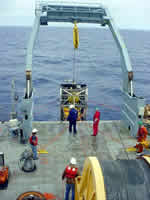| |
| |

ROPOS is recovered after a hard day and
night of work. |
|
Coping
with the Interface
Last night during operations on the seafloor, ROPOS's engineers were having
problems with one of its manipulator arms. I am fascinated at the concept
that this electrical behemoth hundreds of feet below me can function at
all while it is immersed in salt water. It turns out that ROPOS had a
loose wire that was only intermittently responding to commands from the
computers on the ship. This meant that any work requiring the arm's fine
motor skills would not be possible. The bad news was that we had to abort
the dive in order to fix it. It took several hours to bring ROPOS up,
secure it to the deck, have samples and other equipment removed from it.
The good news was that the engineers were able to fix the arm after it
was back on the ship, and we are now ready to use ROPOS for another dive.
Hooray!
| |

Brooke Silvers and Kevin Roe (both from
University of Washington) work on
their chemistry samples in the main lab. |
|
But
then this morning, I was introduced to the next pitfall of oceanography:
weather. I was greeted this Sunday morning by a wall of clouds all around
the ship. At home, I appreciate a foggy day because I associate them with
poor visibility, less boat traffic, low winds and great fishing. Well,
I wasn't too concerned about boat traffic out here and I've got no plans
to fish in the near future but I wasn't quite sure what this would mean
to the scientists and crew. I did immediately feel a sense of sadness
when I entered the galley for breakfast, though. Over our oatmeal and
french toast, the disappointed people at my table filled me in on this
weather system that was unusual to me, but not uncommon out here. We are
caught in a gradient between a high and low pressure system which is enabling
the winds to build. After breakfast, Keith Tamburri, one of the ROPOS
engineers, showed me the erratic behavior of this morning's winds on one
of the ship's computers. If we deployed ROPOS in something less than 20
knot winds and already had been on a dive when winds kicked up to 20-25
knots, we would have been able to stay down and just keep an eye on the
winds. However, if we start out with 20-25 knot winds when we deploy ROPOS,
by the time it actually leaves the deck the winds can easily pick up to
30 knots, and we also have to worry about "snap loads". Picture
our ship bobbing up on the wave's crest and down into the wave's trough.
When the seas build and the ship is towing a heavy item (such as ROPOS)
by a cable, there is a period of time when the item may not move up and
down at the same rate as the ship. When this happens, a heavy item may
actually jerk the line. This would be severely damaging to the piece of
equipment. You can probably imagine why a decision was made to hold off
with ROPOS's next dive. The engineers will evaluate the weather again
in six hours. That will give the crew time to prepare and the weather
time to play out.
As
the Chief Scientist Bob Embley expressed, sometimes it seems that going
out to sea has more unknowns than going into space. In space you deal
with one atmosphere of pressure (granted, going from zero to one atmosphere
is a big deal), but beyond that, everything you deal with is in air or
a vacuum. For deep-sea research, however, you must deal with incredible
frequent pressure differences (as you bring the equipment up and down
through the course of the cruise), corrosive properties of seawater, and
the interface between the air and the sea (that's the one that's causing
all the problems right now). Even though there's disappointment and long
faces while we wait to dive again, I'm sure only a handful of people on
this ship would rather be an astronaut. They know that this is all part
of the gamble you take when you go to sea. What we planned to do, while
waiting for the weather to decide what it was going to do, was to keep
moving down the expedition's tasks and take on whatever would involve
quick deployment or retrieval. We were able to accomplish a great deal
today, even if our number one task was delayed. We deployed two moorings
that will monitor water temperature and currents over the next year for
the NOAA Vents Program. Some people caught up on processing their samples,
some people caught up on some much needed sleep, some people did their
laundry, and some people arranged a ping pong tournament, which should
provide an excellent lesson in physics as well as some down-time entertainment
for all.
|
|
| |
Student's
Question of the Day:
Visitors
at the Hatfield Marine Science Center in Newport Oregon ask, "What
are some of the results from the work you've done so far on this cruise?"
One of
the benefits of working at the NeMO Observatory is that we are
learning about changes that happen here from one year to the next
(time-series measurements). After the 1998 eruption at Axial Volcano,
a
large area was covered by the new lava flow, a "clean slate"
of sorts. In
addition to the knowledge that has been gained by watching life colonize
new
hydrothermal vents, scientists have also been able to look at the physical,
geologic, and chemical processes that occur after a volcanic eruption.
The
time-series study is similar to what has been done at Mt St Helens since
its
eruption in 1980.
|
|

